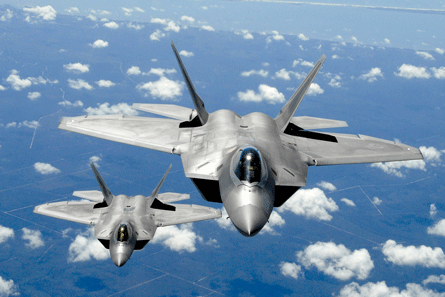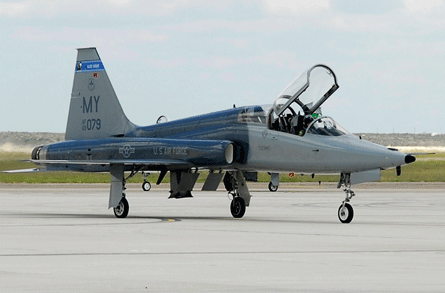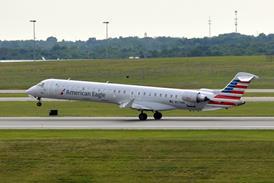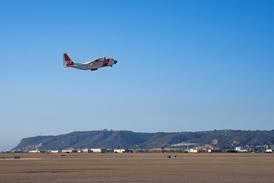The need for a more-capable trainer to prepare pilots to fly new-generation fighters could prompt the US Air Force to push forward finding a replacement for its T-38s
The US Air Force is considering accelerating its efforts to replace the Northrop T-38 Talon trainer, following its early experience in preparing pilots to operate the Lockheed Martin F-22 Raptor.
Although it has recently been the subject of a $150 million upgrade to bring it to the T-38C configuration, the USAF's current supersonic trainer remains "ripe for technology insertion", says Brig Gen Bob Otto, deputy director air and space operations for the service's Air Education and Training Command. Noting that the aircraft - which is used to prepare pilots for fighter and bomber types - is not suitable for an introduction to fighter fundamentals course or for night training, he says: "Its g limits are not sufficient to prepare for a fifth-generation fighter.

"I think we still fall short on how we train pilots to fly fighters," says Otto, who notes that an initial batch of three ab initio students for the F-22 - the first of which were to begin converting onto the Raptor during March - completed so-called "top-off" training on Lockheed F-16s. A replacement for the T-38 should have better g performance and enable the service to download hours from expensive types such as the F-22 and Lockheed's F-35 Joint Strike Fighter, he says.
F-22 baseline cost
Conversion to the F-22 requires 49 sorties: six transition flights, plus 29 air-to-air, six air-to-ground, and four missions each on air combat tactics and night operations. The total course lasts 155 days: five fewer than for the USAF's Boeing F-15E Strike Eagle. Otto cites theF-22's baseline per-hour operating cost as $20,000 - 10 times that of the T-38 - but says this figure was calculated using only the type's use of "gas and oil, and some maintenance".
Activities with the F-22 have also been massively more expensive to conduct than estimated, particularly with regard to the demands of supporting the stealth fighter under training conditions.
"We underestimated by a factor of between four and seven the time to maintain the training demands of, for example, low-observability," says Otto. "It takes a while to mature a weapon system, but at the moment we want it to be as good [in stealth performance] as it can be. We're working hard to learn from that."
Having to conduct additional work to maintain LO characteristics on aircraft dedicated for training duties has reduced the number of Raptors available for pilot conversion, while the F-22's stealth characteristics also means the type requires 40% more other aircraft to support its training missions than the F-15. "It can be hard to find sufficient adversaries," says Otto, adding: "It's like clubbing baby seals - how do you get people to volunteer against you when they're just going to die?"
This means training has sometimes been conducted by pitting F-22 versus F-22: a move that is both expensive and poses its own difficulties in terms of stealth, but which is adding momentum to a consideration to bring forward the T-38's retirement from an AETC target of between 2020 and 2027. "We might try to accelerate that by a year or two," says Otto, who adds that the USAF could even select a suitable new adversary aircraft to fly against the Raptor.
UK experience
The UK Royal Air Force has had a similar experience with its Eurofighter Typhoons, says Wg Cdr Johnny Stringer, officer commanding its 29 Sqn operational conversion unit. "There would be a benefit in having a training aircraft that could replicate the g onset and handling," he says.
Eight ab initio pilots have so far transitioned onto the RAF's growing fleet of Typhoons, with these having arrived at 29 Sqn with around 300 flight hours, including lead-in fighter training on the BAE Systems Hawk at RAF Valley in the UK or using the NATO Flying Training in Canada system at Cold Lake, Alberta. The Typhoon conversion course totals 43 sorties and 50 flight hours, but a slight increase is expected with the introduction of a multirole syllabus later this year.
 |
|---|
| A replacement for the T-38C with better g performance could cut time in the F-22 and F-35 |
Simulators
Simulator-based training is viewed as another key area of improvement, with exponents saying it can be used to get the most out of each hour in the air. "Using simulators frees up valuable flying time," says Royal Netherlands Air Force Air Cdre Peter Berlijn, steering committee chairman for the multinational EuroNATO Joint Jet Pilot Training scheme. "It doesn't mean fewer flying hours, but better training when you fly."
Otto believes simulation must play a greater role in F-22 and F-35 training, noting: "The simulator must be able to fill training gaps."
But enhancements to the Raptor training system must be found quickly. The AETC - which had an operating cost of more than $1 billion in fiscal year 2007 and is expected to amass almost 540,000 flying hours this year - has been tasked with delivering savings worth $164 million by FY2012. "That is not going to be an easy feat," says Otto, who adds: "We are turning over every rock."
Source: Flight International























